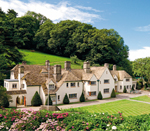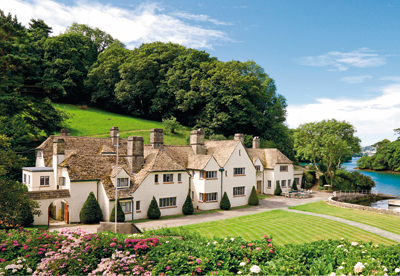Two country houses for sale in South Hams
With its mild climate and miles of heritage coastline, the South Hams area of Devon is popular with sailors and second-home buyers alike


With its 56 miles of heritage coastline, sheltered estuaries and wooded creeks, the dreamy South Hams area of south Devon is a Mecca for yachtsmen and wealthy second-home buyers, many attracted by the mildest climate to be found in Britain. And that's how it was in 1926, when former army officer Ian MacDonald, still suffering from the effects of a wartime gas attack, brought his American wife down from London in search of a coastal retreat.
Rejecting the local estate agent's suggestion of a villa in Torquay, the young couple wandered the hills and narrow lanes south of Kingsbridge, before stumbling on a pair of old cob-and-thatch cottages set into the hillside on the edge of a hidden creek near the tiny village of South Pool. They ended up buying not only the cottages, but also the surrounding farmstead, comprising a 155-acre peninsula between South Pool Creek and Goodshelter Creek, with 35 acres of foreshore (on long-term lease from the Duchy of Cornwall) adjoining the Salcombe estuary.
In 1928, a fire caught the thatch and destroyed both cottages, but soon afterwards, work began in earnest on the construction of a substantial new house. The builder was Murch of Salcombe, and the stone for the walls was quarried from the site of the 1930s Boat House, with the stone for the roof tiles transported directly from the Cotswolds.

Mr MacDonald died in 1948, and a year later, his wife moved back to New York. Their son Robert, then an officer in the Marines, took over the running of the estate and improved it significantly over the years, later establishing a successful dairy herd of 200 Ayrshire cows. Now in his eighties, Mr MacDonald has decided to consolidate his American roots and rejoin his five sons in the USA, where he and his wife, Carolyn, already have a Long Island home. So this week sees the launch, in Country Life, of the extraordinarily private, magical Gullet estate, at a guide price of ‘excess £10 million' through Savills (01392 455755).
High tide on a golden, early-September morning was the moment to savour Gullet's unique setting behind its elegant, serpentine sea wall, and the design of the pleasantly rambling, 9,000sq ft, main house, inspired partly by the summer homes of Cape Cod and the Adirondacks, where Mr MacDonald first met his wife, and partly by the Arts-and-Crafts ethos of Lutyens and Jekyll, both then at the height of their fame. Approached by a long private drive that runs along the side of South Pool Creek, the house-built into the hillside to protect it from the prevailing wind, and visible only from the sea-has four reception rooms, including a 40ft drawing room, a kitchen, a three-room master suite, six further bedrooms, four further bathrooms and a staff flat.
For grand occasions, the 3,000sq ft Home Barn at the rear of the house provides an impressive 47ft ballroom with a minstrel's gallery, a heavily beamed ceiling and a large open fireplace. The estate also has six cottages and various buildings with potential for conversion, including two sets of early-20th-century model farm buildings, a former creamery and a second range of farm buildings, currently used by the tenant, who farms under a short-term Farm Business Tenancy.
Flowers bloom in December in this part of Devon, and the terraced formal gardens surrounding the house are full of colour, as are the slopes of the former walled cutting garden, which discreetly encloses the swimming pool. The land, unencumbered by public footpaths or rights of way, is divided by hedges and banks into traditional small enclosures rising to some 260ft above sea level, with glorious views from the summit.
Sign up for the Country Life Newsletter
Exquisite houses, the beauty of Nature, and how to get the most from your life, straight to your inbox.
For the late John Cornforth, Grade I-listed Bridwell Park at Uffculme, near Tiverton, was another of Devon's ‘unsung surprises'. Writing in Country Life (March 19, 1981), Mr Cornforth described the history and interiors of the house built between 1774 and 1779 by Richard Hall Clarke and eventually sold by his family in the early 1980s. That article later proved to be of major significance when, in 1991, Bridwell, then owned by the notoriously enterprising Andrew Davis, was gutted by a fire, which left only the outer walls standing.
The illustrations from Country Life were used by English Heritage to re-create (at vast expense) Bridwell's Georgian interiors. The original fireplaces were retained and restored within the original rooms, with their fine plasterwork, oak floors and splendid mahogany doors. The basement was originally restored as offices, but these have been re-created as family rooms, which include a home cinema.
After the failure of a planning application for housing development at Bridwell, Mr Davis abandoned ship, and the estate was eventually sold to Robert Tchenguiz's Rotch Property Group. Unoccupied since 1991, the house and estate looked unloved and unlived-in, and buyers came and went until, in October 1997, it was bought privately by Lord Ivar Mount-batten, who had sold his Moyns Park estate in Essex and was looking for pastures new. For the past 14 years, Bridwell Park has been the family home of Lord and Lady Mountbatten and their three daughters, but, following the couple's decision to go their separate ways, the estate is back on the market through Knight Frank (01392 423111) and Savills (01392 455755) at a guide price of ‘offers over £4 million'.
During his tenure, Lord Mountbatten has consistently improved the house and 123-acre estate, creating a commercial deer herd within the ring-fenced, Grade II-listed deer park, and a successful chicken-rearing unit on farmland to the north of the original farm buildings. He has also restored the Grade II*-listed private chapel built in 1792 as a museum to house Richard Hall Clarke's collection of Capt Cook memorabilia; the building was to provide an ideal setting for Prince Edward's stag-weekend celebrations. The spectacular pool complex, in a modern building away from the house, is understandably popular with the younger generation, and a fully-equipped helicopter hangar guarantees a swift getaway, should the need arise.
With its 14,000sq ft of living space on four floors, the classic Georgian house feels simultaneously grand and surprisingly compact, with all the main rooms-drawing room, dining room, morning room and library-grouped around the beautiful elliptical entrance hall, described by John Cornforth as ‘the first surprise of Bridwell'. A huge conservatory looks out across the park where Bridwell's herd of fallow deer roams free, to the artificial lake in the hollow below, and beyond that to the Culm valley and the Haldon Hills. Thanks to the 1991 rebuild, Bridwell Park now has an efficient central-heating system and eight modern bathrooms to complement its eight spacious first-and second-floor bedrooms.
* Subscribe to Country Life and up to £50
Country Life is unlike any other magazine: the only glossy weekly on the newsstand and the only magazine that has been guest-edited by HRH The King not once, but twice. It is a celebration of modern rural life and all its diverse joys and pleasures — that was first published in Queen Victoria's Diamond Jubilee year. Our eclectic mixture of witty and informative content — from the most up-to-date property news and commentary and a coveted glimpse inside some of the UK's best houses and gardens, to gardening, the arts and interior design, written by experts in their field — still cannot be found in print or online, anywhere else.
-
 'Monolithic, multi-layered and quite, quite magnificent. This was love at first bite': Tom Parker Bowles on his lifelong love affair with lasagne
'Monolithic, multi-layered and quite, quite magnificent. This was love at first bite': Tom Parker Bowles on his lifelong love affair with lasagneAn upwardly mobile spaghetti Bolognese, lasagne al forno, with oozing béchamel and layered meaty magnificence, is a bona fide comfort classic, declares Tom Parker Bowles.
By Tom Parker Bowles Published
-
 Country houses, cream teas and Baywatch: Country Life Quiz of the Day, April 24, 2025
Country houses, cream teas and Baywatch: Country Life Quiz of the Day, April 24, 2025Thursday's Quiz of the Day asks exactly how popular Baywatch became.
By Toby Keel Published
